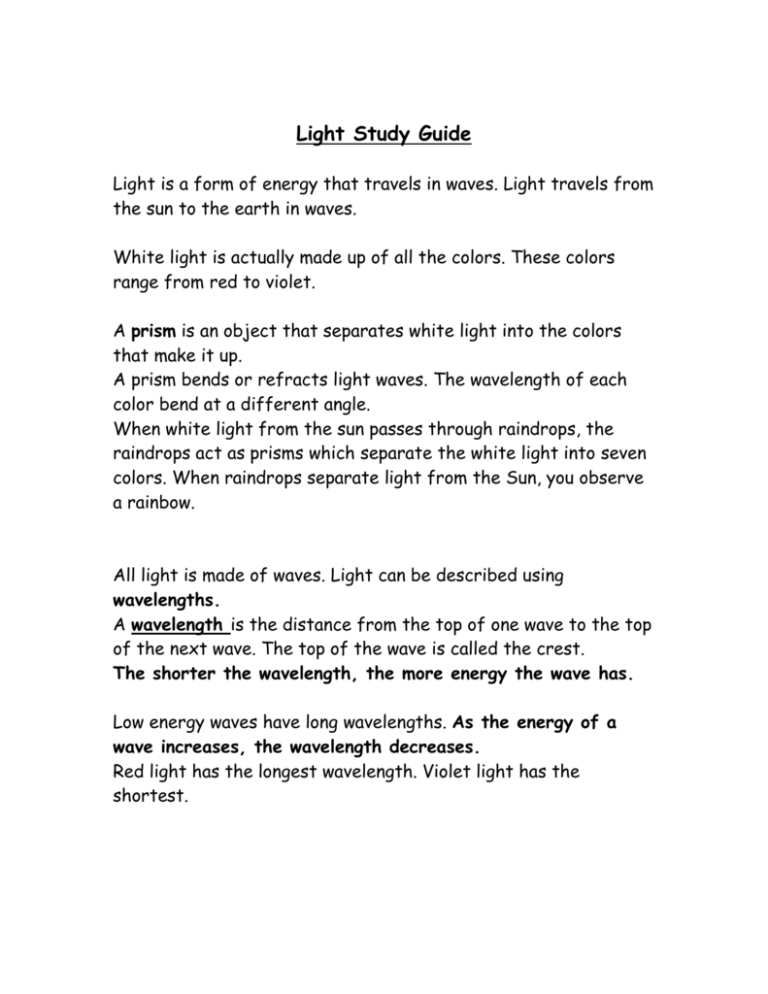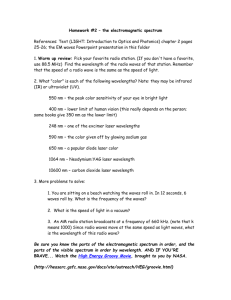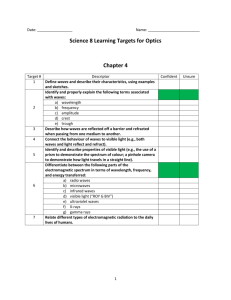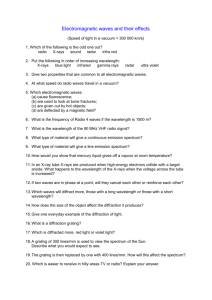Light Study Guide
advertisement

Light Study Guide Light is a form of energy that travels in waves. Light travels from the sun to the earth in waves. White light is actually made up of all the colors. These colors range from red to violet. A prism is an object that separates white light into the colors that make it up. A prism bends or refracts light waves. The wavelength of each color bend at a different angle. When white light from the sun passes through raindrops, the raindrops act as prisms which separate the white light into seven colors. When raindrops separate light from the Sun, you observe a rainbow. All light is made of waves. Light can be described using wavelengths. A wavelength is the distance from the top of one wave to the top of the next wave. The top of the wave is called the crest. The shorter the wavelength, the more energy the wave has. Low energy waves have long wavelengths. As the energy of a wave increases, the wavelength decreases. Red light has the longest wavelength. Violet light has the shortest. 2 Spectrum is a range of light waves with different wavelengths and energies. The seven colors of light that make up white light are called the visible spectrum. These seven colors are called the visible spectrum because they are light waves that we can see. There are many waves that we can’t see—the visible spectrum is only a small part of the electromagnetic spectrum. The electromagnetic spectrum is a range of all light waves with varying wavelengths, including the visible spectrum. The different types of waves that make up the electromagnetic spectrum are: gamma rays, X rays, ultraviolet light, visible light, infrared light, microwaves, and radio waves. Each of these waves have different wavelengths and energies. Radio waves have the lowest energy, then television waves, microwaves, infrared waves, invisible light, ultraviolet waves, X ray waves, and gamma waves. 3 Light waves can travel through empty space and through air, water, and other materials. How does light travel? Light waves travel in straight lines. They do not change direction unless they are reflected or refracted. Light strikes objects like a tree. The light cannot pass through the tree and it cannot go around the tree. A shadow forms when light is blocked. Shadows are places where light does not fall. The size of the shadow depends on where the light source is—the closer an object is to a light source, the bigger the shadow. Light coming from above an object creates a shorter shadow. Light coming from the side of an object creates a longer shadow. As Earth rotates on its axis, the Sun moves across the sky. It casts its shortest shadow when it is directly overhead, at noon. The Sun casts its longest shadow when it first appears and before it disappears. When light waves hit substances, three things can happen: Light can be refracted, absorbed, or reflected. Reflection Reflection occurs when light strikes a surface and bounces off. Most of the light that reaches your eyes is reflected light. We see the light waves that bounce off things—the light that is reflected by substances. 4 Most surfaces reflect at least some light. Smooth, shiny surfaces reflect almost all of the light falling on them. Light changes direction when it is reflected off a surface. The light rays striking the surface are the incoming rays while the reflected light rays are the outgoing rays. Reflection of light is predictable—light waves reflect in the same way. Light waves travel in straight lines. When a light wave hits an object and reflects, it will reflect in a straight line. If the light wave hits an object at an angle, it will reflect at the same angle. When light strikes a surface, it is reflected at an outgoing angle equal to its incoming angle. The Law of Reflection says that the incoming angle is equal to the outgoing angle. Refraction Refraction occurs when light travels from one material into another. The light either speeds up or slows down. Some materials allow light to pass through and refraction happens when light passes through glass, water, light plastic, and other transparent materials. Light travels at different speeds in different materials. The more dense the material, the slower light travels through it. As light travels more slowly, it bends more. 5 For example, water is denser than air and it is harder for light to travel through water than air. Light slows and bends at the point where it passes from air to water. The ray of light does not curve during refraction—it simply changes direction as it passes from one material to another. Lenses are tools that refract light. They are used to gather light rays or spread them apart. Convex Lens A convex lens is thicker in the middle than on the ends. It bends light waves toward a point. A convex lens can make objects look larger. Concave Lens A concave lens is thinner in the middle than on the ends. It spreads out light waves that pass through it. A concave lens can make objects look smaller. A magnifying glass is a convex lens. When you hold a magnifying glass near an object, light rays are reflected from the object to the lens of the magnifying glass. The lens then refracts the rays in such a way that the object looks bigger to you. Microscopes, telescopes, and cameras also use convex lenses. 6 Why Do Objects Appear to be a Certain Color? When objects do not absorb a wavelength of light, they reflect it. The color that is reflected is the color an object appears to be. For example, white light shines on a green leaf. The leaf absorbs the entire visible spectrum of light energy except for light that has wavelengths for green light. These light waves are reflected off the leaf and into your eyes—the leaf appears green. White objects do not absorb any light energy—white results from all wavelengths being reflected. White clothing or objects are cooler when placed in the sunlight because white does not absorb light energy. Black objects absorb all the wavelengths of the visible spectrum. Black clothing and objects are warmer when placed in the sunlight. Opaque materials block light rather than let it pass through. Wood, metal and people are opaque objects. Transparent materials let light pass through. Glass and water are transparent. Translucent materials reflect some light and let the rest pass through. Cloudy looking plastics are translucent. New Technology and Light Lasers 7 Lasers are thin beams of light with one wavelength. Lasers are so powerful that they can cut through steel. Lasers are used to do delicate surgery and they are also used to make and interpret CD’s. Optical Fibers Optical fibers are tubes of glass or plastic. They reflect light along the entire length of their fiber. The information coded in optical fibers can travel at nearly the speed of light. Optical fibers can bring you email, colorful websites, music and more over the internet. **********************************************************








